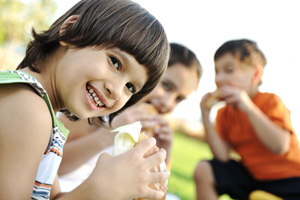Healthy lunchbox ideas!

You may find a great snack or sandwich idea only to discover that it comes home soggier than your dish cloth. "I wouldn't have eaten that either!" you say. So, here are some tips and tricks to help your kids eat a healthy, wholesome lunch while they're at kindergarten, daycare or school.
Stop The Sog! Put 'wet' fillings like tomato or mayonnaise between two pieces of lettuce or some other ingredient that will prevent the bread going soggy.
Variety's the Spice of Life. The same old honey sandwiches everyday will get boring very fast. Mix it up with wraps, pitas, or rolls for a change.
Say Cheese! A slice of cheese will help protect children's teeth from decay. For the same reason, encourage them to swish some water around their mouth after eating.
Easy access. You won't want muesli bars coming home because tiny hands couldn't open the packaging. A little tear in the top of the packet as it goes into the lunchbox will help kids open their own food without needing to ask a teacher for help.
Picky, Picky. A picky eater will do well by filling up their own lunchbox. Of course, this option only works if you only have healthy food on hand for them to choose.
Bake a batch (or three). If time is a valuable resource, then whip up a big batch of healthy muffins once a month to freeze. Try cheese and pumpkin scones, or zucchini and chocolate muffins. The frozen muffin will keep the rest of the lunchbox cool as it thaws in time for lunch.
Get creative. Sandwiches made in the shape of a Star Wars Fighter Ship or a love heart will be much more appealing to a little person. Stock up on some of the amazing array of cookie cutters available.
Freeze Please. Freezing yoghurt tubes, fruit squirts or a water bottle will help keep the rest of the lunchbox cool and safe from bugs. (the zone for bugs to start is 5OC to 60OC )
Compartmentalise! Lunchboxes with little compartments are good for helping appeal to independent eaters as well as help you cut down on plastic and waste.

Remember where possible to include something from each food group.
· Bread, cereals, rice, pasta, noodles
· Vegetables and legumes
· Fruit
· Milk, yoghurt, cheese and fish
· Meat, poultry, eggs, nuts and legumes
For example, a wholemeal sandwich with turkey, cucumber and cheese, an orange, carrot sticks and a yoghurt covers all the bases.
Below is a list of ideas to help inspire you to keep up the variety in your children's lunches, either at home or away.
· Nori (seaweed) rolls with tuna and/or vegetables
· Boiled eggs
· Cheese cubes and cheery tomatoes
· Toasted sandwiches or pizza
· Tubs of dips or hummus with vegetable sticks (try having your one make a lemon and vegemite dressing. Combining a favourite food with others can help acceptance)
· Soups or hot noodles in thermos containers in winter.

Things to keep in mind:
· If a product has added sugars then ensure they're not listed in the top three ingredients on the packet.
· Biscuits, chips, bars, flavoured milk and pastries can all impact on the nutrition of a meal as well as displace healthy foods and meals later due to the large amount of energy in such foods.
· Caffeine and kids aren't a good mix, so best avoid foods and drinks containing caffeine :)
· Sodium should be kept to a minimum, and will ideally not exceed 120mg per 100g.
· Fruit Juices are not necessary. It is better to eat fruit and drink water. Apple juice in particular can cause upset tummies and diarrhoea.
· Wash all fruit and vegetables to reduce the risk from any nasties.
· Children with wiggly or lost teeth may find softer breads and foods easier to eat.
This basis of this article was supplied by nutritionist Leanne Cooper. You can find out more about Leanne and more of her advice on ways to encourage healthy eating in your youngsters by going to www.sneakys.com.au

